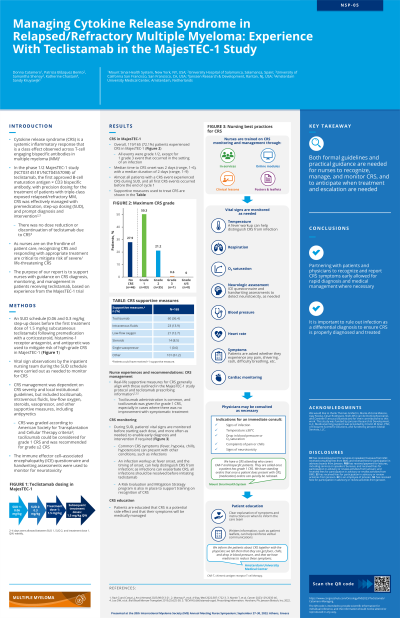Nursing Symposium
Poster Session 1
NSP-05: Managing Cytokine Release Syndrome in Relapsed/Refractory Multiple Myeloma: Experience With Teclistamab in the MajesTEC-1 Study
Wednesday, September 27, 2023
1:30 PM - 2:30 PM EEST


Donna Catamero, ANP-BC, OCN, CCRC
Associate Director, Myeloma Translational Research
Mount Sinai Health System, New York, NY, USA, United States
Introduction: Cytokine release syndrome (CRS) is a systemic inflammatory response commonly associated with T-cell engagers. In the MajesTEC-1 study of teclistamab, the only approved BCMA×CD3 bispecific antibody with a personalized, weight-based, and flexible dosing schedule for the treatment of triple-class exposed relapsed/refractory multiple myeloma, CRS was effectively managed with pre-medication, step-up dosing, and prompt diagnosis and intervention (Martin et al, Cancer, 2023). As nurses are on the front line of patient care, recognizing CRS and responding with appropriate treatment are critical to mitigate risk of severe/life-threatening CRS. Here, we aim to support nurses with guidance on CRS diagnosis, monitoring, and management in patients receiving teclistamab, based on the MajesTEC-1 experience.
Methods: A step-up dosing schedule (0.06 and 0.3 mg/kg step-up doses before first treatment dose of 1.5 mg/kg subcutaneous teclistamab), requiring premedication with a corticosteroid, histamine-1 receptor antagonist, and antipyretic, was used to mitigate risk of high-grade CRS. Frequent vital sign observations (every 2–4 hours per institutional guidelines) by the inpatient nursing team during step-up dosing were required to monitor for CRS. CRS management was dependent on CRS severity but included tocilizumab (36.4% of patients), intravenous fluids (13.9%), low-flow oxygen (12.7%), steroids (8.5%), single vasopressor (0.6%), and other supportive measures, including antipyretics.
Results: Overall, 72.1% of patients experienced CRS; all events were grade 1/2, except for one grade 3 event that occurred in the setting of an infection. Among patients with CRS, 96.6% experienced CRS during step-up dosing; thus, frequent monitoring during this period is critical. As common CRS symptoms (fever, hypoxia, chills, hypotension) can present with other conditions, a differential diagnosis is important to ensure that CRS is properly diagnosed and treated. CRS was monitored inpatient with vital signs checked frequently (every 2–4 hours) or continuously through wearable devices. Partnering with patients and physicians to recognize and report CRS symptoms early allowed for rapid intervention and transfer to intensive care where necessary. As infections can exacerbate CRS, patients should be examined for signs of infection, and all infections should be resolved before initiating teclistamab. In MajesTEC-1, tocilizumab could be considered for grade 1 CRS and was recommended for grade 2 events. At our institutions, tocilizumab was given for grade 1 CRS (either generally or if persistent), and no patient had recurrent CRS.
Conclusions: Practical guidance is needed for nurses to recognize and monitor CRS and to anticipate when treatment and escalation are needed to ensure successful administration of teclistamab. Data previously presented at the 2023 Oncology Nursing Society (ONS) Annual Meeting.
Methods: A step-up dosing schedule (0.06 and 0.3 mg/kg step-up doses before first treatment dose of 1.5 mg/kg subcutaneous teclistamab), requiring premedication with a corticosteroid, histamine-1 receptor antagonist, and antipyretic, was used to mitigate risk of high-grade CRS. Frequent vital sign observations (every 2–4 hours per institutional guidelines) by the inpatient nursing team during step-up dosing were required to monitor for CRS. CRS management was dependent on CRS severity but included tocilizumab (36.4% of patients), intravenous fluids (13.9%), low-flow oxygen (12.7%), steroids (8.5%), single vasopressor (0.6%), and other supportive measures, including antipyretics.
Results: Overall, 72.1% of patients experienced CRS; all events were grade 1/2, except for one grade 3 event that occurred in the setting of an infection. Among patients with CRS, 96.6% experienced CRS during step-up dosing; thus, frequent monitoring during this period is critical. As common CRS symptoms (fever, hypoxia, chills, hypotension) can present with other conditions, a differential diagnosis is important to ensure that CRS is properly diagnosed and treated. CRS was monitored inpatient with vital signs checked frequently (every 2–4 hours) or continuously through wearable devices. Partnering with patients and physicians to recognize and report CRS symptoms early allowed for rapid intervention and transfer to intensive care where necessary. As infections can exacerbate CRS, patients should be examined for signs of infection, and all infections should be resolved before initiating teclistamab. In MajesTEC-1, tocilizumab could be considered for grade 1 CRS and was recommended for grade 2 events. At our institutions, tocilizumab was given for grade 1 CRS (either generally or if persistent), and no patient had recurrent CRS.
Conclusions: Practical guidance is needed for nurses to recognize and monitor CRS and to anticipate when treatment and escalation are needed to ensure successful administration of teclistamab. Data previously presented at the 2023 Oncology Nursing Society (ONS) Annual Meeting.
